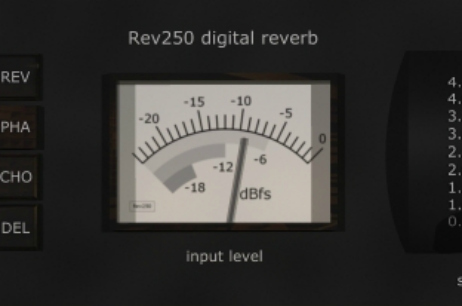Let’s add some unique and mysterious atmosphere to two clean guitar parts with Rev250! First we will apply a distinct phaser effect to the rhythm part, and then give the lead a whole new sonic color with the great vintage reverb module. Since we don’t want (or need) to save any CPU we place the two instances of Rev250 directly onto the guitar tracks.
Let’s listen to the unprocessed mix first:
Rhythm guitar
To activate the phaser in Rev250 we click the PHA-button on the left (indicated by a yellow light). In this mode, the first slider determines the amplitude or amount of the effect. We set it almost to the highest value, around 4s/250ms. The second slider controls the speed of the phaser. Because we already set a pretty high value for the amplitude, we don’t want to mess up the sound completely and therefore set the speed slightly above the 0dB mark on the left. For the third slider isn’t active in phaser mode we can ignore it and move on to the last one, which determines the pre-delay of the effect. We want the phaser to be active right when the audio signal comes in, so we turn it all the way down.
Lastly we set the Dry/Wet-control on the right to about 50% to retain some of the presence and definition of the unprocessed signal.
The interface of this instance should now look something like this:
Lead guitar
Now let’s get to the lead guitar. We leave Rev250 in reverb mode (REV), and also leave V1 (vintage 1) activated on the right. This algorithm is full of character and therefore ideal for that somewhat ‘cavernous’ reverb sound we’re looking for.
We turn the first slider, which defines the overall length of the effect, almost all the way up. Then we boost the lows just a tiny bit with the second slider, to give the sound a little bit of weight, before we take out as much highs as we can (-12dB) using the third slider. This gives us a great, dark tail, which suits this track perfectly. Eventually we introduce some pre-delay with the last slider (just below 20ms). After all, this is a pretty drastic reverb we’ve created here, yet we want to be able to preserve the initial attacks of the single notes of the guitar. For this reason we also turn down the Mix-control (Dry/Wet) to about 45%. Finally, we narrow down the stereo field of the lead guitar a bit by setting the Mono/Wide-control to about 12 o’clock.
The interface of this instance should now look something like this:
The result
All right, let’s have a listen to the final mix:
You can download both presets for Rev250 here: Rev250 Atmos Guitar Presets


